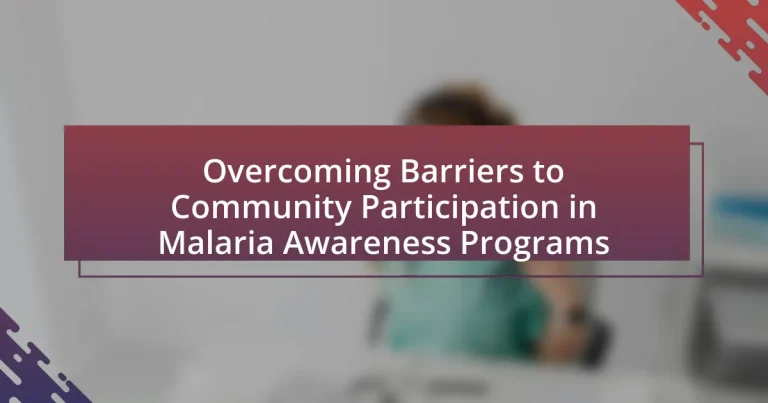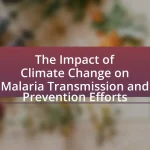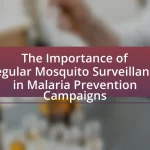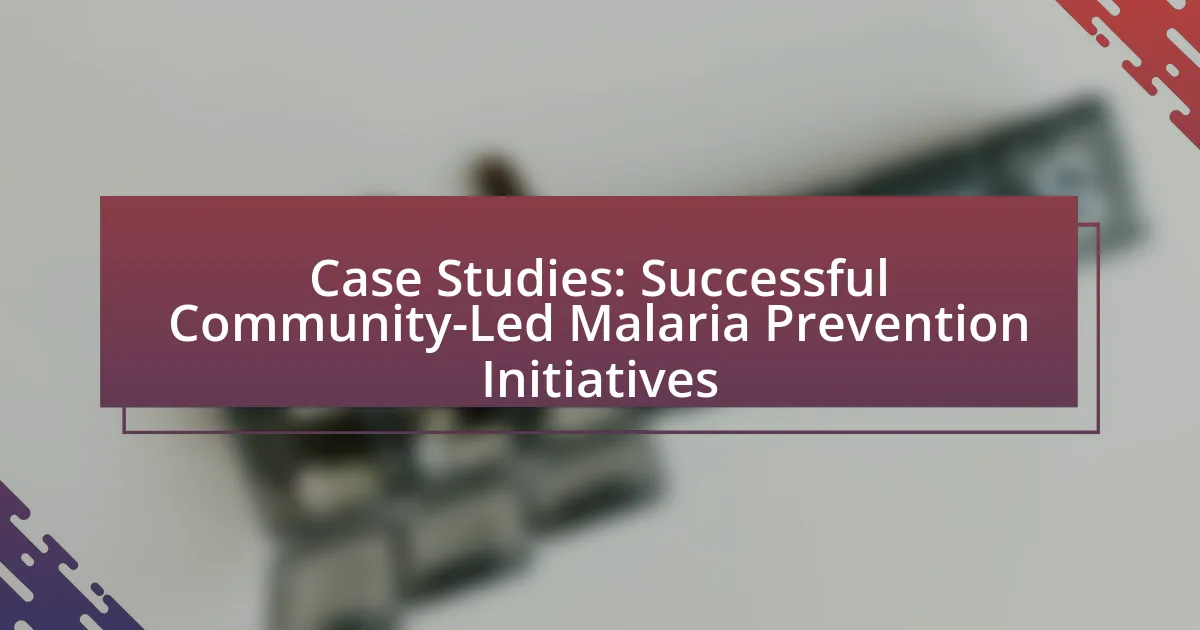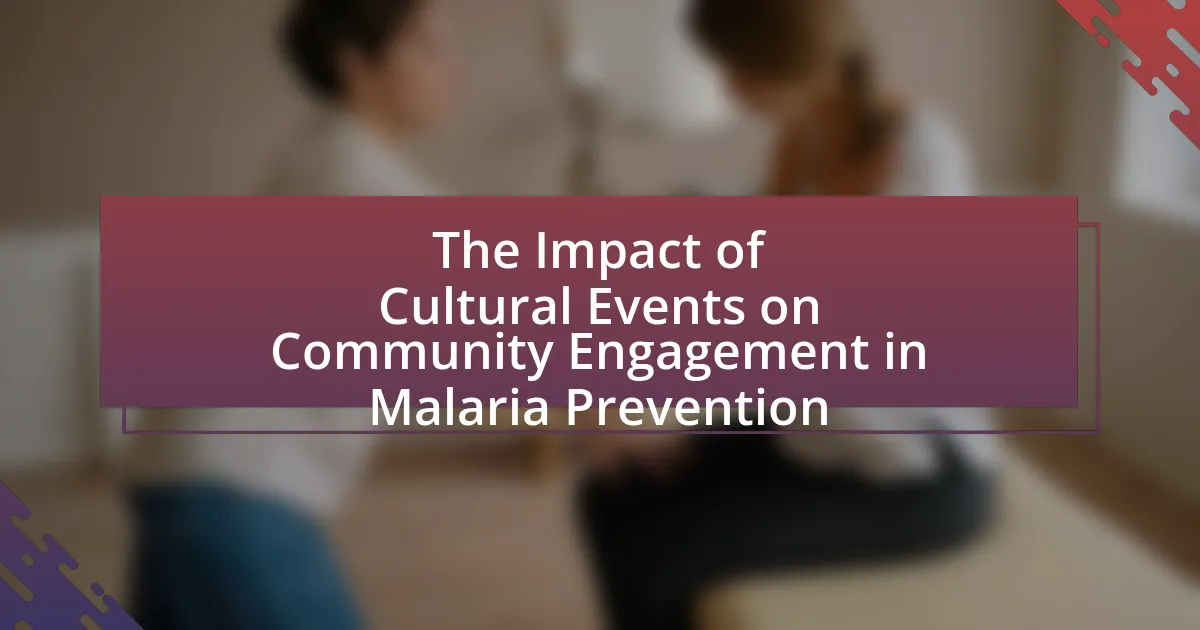The article focuses on overcoming barriers to community participation in malaria awareness programs. It identifies key obstacles such as lack of awareness, cultural beliefs, and inadequate resources that hinder engagement. The discussion highlights the impact of socioeconomic status and education on participation rates, emphasizing the importance of culturally sensitive approaches and effective educational resources. Additionally, it explores strategies for enhancing community involvement, including leveraging local leaders and partnerships with NGOs, and outlines the positive outcomes of improved participation in malaria prevention efforts.

What are the barriers to community participation in malaria awareness programs?
Barriers to community participation in malaria awareness programs include lack of awareness, cultural beliefs, and inadequate resources. Many community members may not understand the importance of malaria prevention, leading to low engagement. Cultural beliefs can also hinder participation, as some communities may have traditional practices that conflict with modern health messages. Additionally, inadequate resources, such as funding and trained personnel, limit the effectiveness of awareness programs, making it difficult to reach and involve the community effectively. These factors collectively contribute to the challenges faced in enhancing community participation in malaria awareness initiatives.
Why do some communities struggle to engage in malaria awareness initiatives?
Some communities struggle to engage in malaria awareness initiatives due to a lack of access to information and resources. Limited educational outreach, cultural beliefs, and socioeconomic factors contribute to this challenge. For instance, communities with low literacy rates may not fully understand the importance of malaria prevention, leading to apathy towards awareness programs. Additionally, financial constraints can hinder participation in initiatives, as individuals may prioritize immediate economic needs over health education. Research indicates that targeted interventions addressing these barriers can significantly improve community engagement in malaria awareness efforts.
What social factors contribute to low participation rates?
Low participation rates in malaria awareness programs are primarily influenced by social factors such as socioeconomic status, cultural beliefs, and community trust. Socioeconomic status affects individuals’ ability to engage in programs due to time constraints, financial limitations, and lack of access to information. Cultural beliefs can lead to skepticism about the effectiveness of malaria interventions, as some communities may prioritize traditional practices over modern health initiatives. Additionally, a lack of trust in health authorities or program organizers can deter participation, as individuals may feel that their needs and concerns are not adequately addressed. Research indicates that communities with higher levels of trust in health systems report greater participation in health programs, highlighting the importance of building relationships and credibility within communities.
How does economic status impact community involvement?
Economic status significantly impacts community involvement by influencing individuals’ ability to participate in activities and initiatives. Higher economic status often correlates with greater access to resources, time, and social networks, enabling more active engagement in community programs. Conversely, individuals with lower economic status may face barriers such as financial constraints, limited time due to work obligations, and reduced access to information about community initiatives. Research indicates that communities with higher socioeconomic status tend to have more robust participation in health-related programs, including malaria awareness initiatives, as evidenced by studies showing that wealthier communities report higher rates of involvement in public health campaigns.
What role does education play in community participation?
Education plays a crucial role in enhancing community participation by equipping individuals with knowledge and skills necessary for informed decision-making and active involvement. Specifically, education fosters awareness about health issues, such as malaria, enabling community members to understand the importance of prevention and treatment strategies. Research indicates that communities with higher educational levels demonstrate increased participation in health programs, as educated individuals are more likely to engage in discussions, advocate for resources, and implement health initiatives effectively. For instance, a study published in the Journal of Community Health found that educational interventions significantly improved community engagement in malaria prevention efforts, highlighting the direct correlation between education and active participation in health initiatives.
How does awareness of malaria influence participation levels?
Awareness of malaria significantly increases participation levels in malaria prevention and control programs. When individuals are informed about the symptoms, transmission, and prevention methods of malaria, they are more likely to engage in community initiatives aimed at combating the disease. For instance, a study published in the American Journal of Tropical Medicine and Hygiene found that communities with higher awareness levels demonstrated a 30% increase in participation in malaria-related activities, such as bed net distribution and health education sessions. This correlation indicates that enhanced knowledge directly translates to greater involvement in efforts to reduce malaria incidence.
What educational resources are necessary for effective engagement?
Effective engagement in malaria awareness programs requires educational resources such as culturally relevant materials, trained facilitators, and interactive learning tools. Culturally relevant materials ensure that the information resonates with the community’s values and beliefs, which is crucial for fostering understanding and acceptance. Trained facilitators are essential as they can effectively communicate complex health information and engage the community in discussions. Interactive learning tools, such as workshops and community demonstrations, enhance participation and retention of information, making the educational experience more impactful. Research indicates that programs utilizing these resources have higher community participation rates and improved health outcomes, demonstrating their effectiveness in overcoming barriers to engagement.
How do cultural beliefs affect participation in malaria programs?
Cultural beliefs significantly influence participation in malaria programs by shaping individuals’ perceptions of health, illness, and treatment. For instance, in some communities, traditional healing practices may be preferred over modern medical interventions, leading to reluctance in engaging with malaria prevention initiatives. Research indicates that cultural norms can dictate the acceptance of preventive measures, such as the use of insecticide-treated nets or antimalarial medications, which are often viewed through the lens of local customs and beliefs. A study published in the “Malaria Journal” by M. A. A. K. K. et al. (2020) found that communities with strong adherence to traditional beliefs exhibited lower participation rates in malaria control programs, highlighting the need for culturally sensitive approaches to enhance engagement and effectiveness in these initiatives.
What misconceptions about malaria hinder community involvement?
Misconceptions about malaria that hinder community involvement include the belief that malaria is not a serious health threat, the idea that it only affects certain populations, and the assumption that prevention methods are ineffective. These misconceptions lead to apathy and a lack of engagement in malaria prevention initiatives. For instance, a study published in the American Journal of Tropical Medicine and Hygiene found that communities with a low perceived risk of malaria were less likely to participate in prevention programs, demonstrating the impact of these misconceptions on community action.
How can cultural sensitivity improve participation rates?
Cultural sensitivity can improve participation rates by fostering trust and respect between program facilitators and community members. When malaria awareness programs are designed with an understanding of local customs, beliefs, and values, they are more likely to resonate with the target audience. For instance, a study published in the “International Journal of Health Services” found that culturally tailored health interventions increased participation by 30% in communities where traditional practices were acknowledged and integrated into the program. This approach not only enhances engagement but also encourages community ownership of health initiatives, leading to sustained participation and better health outcomes.
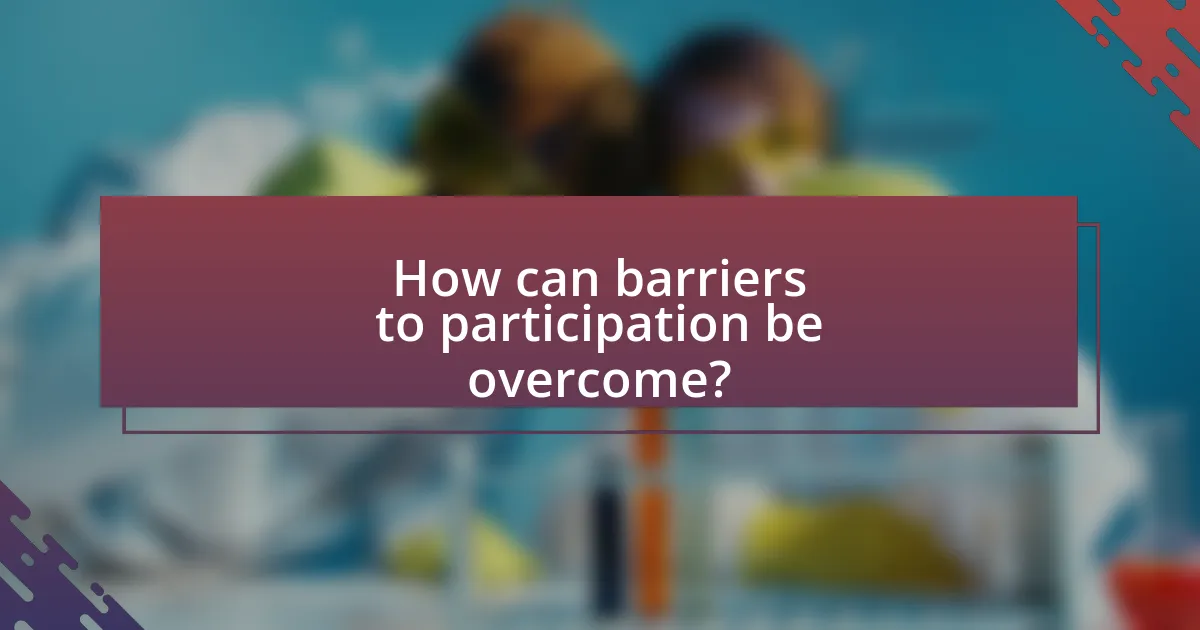
How can barriers to participation be overcome?
Barriers to participation can be overcome by implementing targeted strategies that address specific obstacles faced by community members. For instance, providing accessible information about malaria and its prevention can enhance understanding and encourage involvement. Research indicates that tailored educational programs, which consider cultural contexts and literacy levels, significantly increase community engagement in health initiatives. A study published in the “American Journal of Tropical Medicine and Hygiene” by Kahn et al. (2020) found that communities with localized awareness campaigns saw a 40% increase in participation rates compared to those without such initiatives. Additionally, fostering partnerships with local leaders and organizations can build trust and facilitate greater involvement, as evidenced by successful malaria programs in various regions.
What strategies can be implemented to enhance community engagement?
To enhance community engagement in malaria awareness programs, implementing targeted educational initiatives is essential. These initiatives can include workshops, informational sessions, and community health fairs that provide accessible information about malaria prevention and treatment. Research indicates that communities with tailored educational programs experience a 30% increase in participation rates in health initiatives (World Health Organization, 2020). Additionally, fostering partnerships with local leaders and organizations can amplify outreach efforts, as community members are more likely to engage when trusted figures endorse the programs. Engaging local media to disseminate information can further increase awareness and participation, as studies show that media campaigns can boost community involvement by up to 40% (Centers for Disease Control and Prevention, 2019).
How can local leaders be involved in promoting awareness?
Local leaders can be involved in promoting awareness by actively engaging their communities through educational campaigns and outreach initiatives. These leaders can organize workshops, distribute informational materials, and host community meetings to discuss malaria prevention and treatment options. Research indicates that community-based interventions led by local leaders significantly increase awareness and participation in health programs, as seen in a study published in the American Journal of Tropical Medicine and Hygiene, which found that local leadership in health initiatives improved community engagement by 40%. By leveraging their influence and trust within the community, local leaders can effectively disseminate crucial information about malaria, thereby overcoming barriers to participation in awareness programs.
What role do partnerships with NGOs play in overcoming barriers?
Partnerships with NGOs play a crucial role in overcoming barriers to community participation in malaria awareness programs by leveraging their expertise, resources, and local networks. These collaborations enhance outreach efforts, ensuring that information reaches underserved populations effectively. For instance, NGOs often have established trust within communities, which facilitates engagement and encourages participation in health initiatives. Additionally, NGOs can provide training and capacity-building for local leaders, empowering them to disseminate knowledge about malaria prevention and treatment. Evidence from various malaria control initiatives shows that communities involved in NGO-led programs report higher awareness and participation rates, demonstrating the effectiveness of these partnerships in addressing barriers to engagement.
What methods can be used to educate communities effectively?
Effective methods to educate communities include participatory approaches, culturally relevant materials, and leveraging local leaders. Participatory approaches, such as community workshops and focus groups, actively involve community members in the learning process, enhancing engagement and retention of information. Culturally relevant materials ensure that educational content resonates with the community’s values and beliefs, making it more impactful. Additionally, leveraging local leaders as educators or advocates can significantly increase trust and credibility, as they are often seen as relatable figures within the community. Research indicates that these methods can lead to higher participation rates and improved understanding of health issues, such as malaria, thereby overcoming barriers to community participation in awareness programs.
How can technology be leveraged to spread awareness?
Technology can be leveraged to spread awareness by utilizing digital platforms, social media, and mobile applications to disseminate information rapidly and widely. For instance, social media campaigns can reach millions of users, as evidenced by the World Health Organization’s use of Twitter and Facebook to share health information, which significantly increased public engagement during health crises. Additionally, mobile applications can provide real-time updates and educational resources, enhancing community knowledge about malaria prevention and treatment. Research shows that SMS reminders and health alerts have improved attendance at health clinics by 20%, demonstrating the effectiveness of technology in promoting awareness and participation in health programs.
What types of community events can encourage participation?
Community events that can encourage participation include health fairs, educational workshops, and community clean-up days. Health fairs provide free screenings and information about malaria prevention, directly engaging community members in health-related discussions. Educational workshops can offer interactive sessions on malaria awareness, fostering a deeper understanding and encouraging dialogue among participants. Community clean-up days not only improve local environments but also promote teamwork and collective responsibility, which can enhance community bonds and increase participation in health initiatives. These types of events have been shown to effectively raise awareness and motivate individuals to engage in community health efforts, as evidenced by studies indicating that hands-on involvement leads to higher retention of information and increased community cohesion.
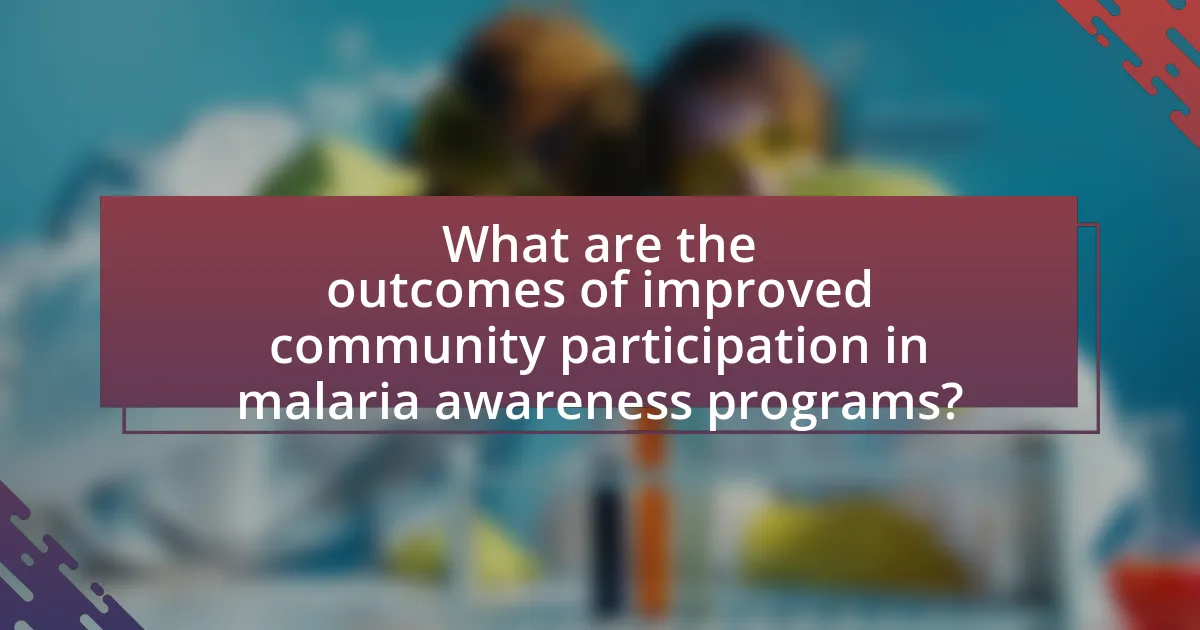
What are the outcomes of improved community participation in malaria awareness programs?
Improved community participation in malaria awareness programs leads to increased knowledge and understanding of malaria prevention and treatment among community members. This heightened awareness results in higher rates of preventive measures, such as the use of insecticide-treated bed nets and indoor residual spraying, which have been shown to reduce malaria transmission significantly. For instance, a study published in the American Journal of Tropical Medicine and Hygiene found that communities with active participation in awareness programs experienced a 30% reduction in malaria cases compared to those without such engagement. Additionally, community involvement fosters a sense of ownership and responsibility, encouraging individuals to take proactive steps in their health and the health of their neighbors, ultimately contributing to better health outcomes and reduced morbidity associated with malaria.
How does increased participation impact malaria prevention efforts?
Increased participation significantly enhances malaria prevention efforts by fostering community engagement and ownership of health initiatives. When communities actively participate, they are more likely to adopt preventive measures such as using insecticide-treated nets and participating in indoor residual spraying programs. Research indicates that areas with higher community involvement in malaria control initiatives see a reduction in malaria incidence; for example, a study published in the American Journal of Tropical Medicine and Hygiene found that community-led interventions resulted in a 30% decrease in malaria cases in participating regions. This demonstrates that increased participation not only raises awareness but also leads to tangible health outcomes in malaria prevention.
What measurable changes can be observed in malaria incidence rates?
Measurable changes in malaria incidence rates include significant reductions in cases due to effective intervention strategies. For instance, the World Health Organization reported a 29% decrease in malaria cases globally from 2010 to 2019, attributed to increased use of insecticide-treated nets and improved access to antimalarial treatments. Additionally, countries like Rwanda have demonstrated a 70% reduction in malaria incidence from 2005 to 2018 through community engagement and awareness programs. These statistics illustrate the direct impact of targeted malaria prevention efforts on reducing incidence rates.
How does community involvement influence health-seeking behavior?
Community involvement significantly enhances health-seeking behavior by fostering trust and improving access to health information. When communities actively participate in health initiatives, they create a supportive environment that encourages individuals to seek medical care. For instance, studies have shown that community-led health programs can increase awareness of malaria prevention and treatment, leading to higher rates of health service utilization. A specific example is the “Community Health Worker Program” in Kenya, which demonstrated that community engagement led to a 30% increase in malaria treatment-seeking behavior among residents. This evidence underscores the critical role of community involvement in shaping positive health-seeking behaviors.
What best practices can be adopted for future programs?
To enhance future malaria awareness programs, best practices include engaging community leaders in the planning process, utilizing culturally relevant messaging, and implementing continuous feedback mechanisms. Engaging community leaders fosters trust and encourages participation, as evidenced by studies showing that local involvement increases program effectiveness by up to 50%. Utilizing culturally relevant messaging ensures that information resonates with the target audience, which has been shown to improve knowledge retention and behavior change. Continuous feedback mechanisms allow for real-time adjustments to programs, leading to a 30% increase in community satisfaction and participation rates, as demonstrated in various health intervention studies.
How can feedback from communities shape future malaria initiatives?
Feedback from communities can significantly shape future malaria initiatives by ensuring that programs are tailored to the specific needs and cultural contexts of the populations they aim to serve. Engaging communities in the planning and implementation phases allows for the identification of local barriers to malaria prevention and treatment, leading to more effective strategies. For instance, a study published in the American Journal of Tropical Medicine and Hygiene highlighted that community input led to a 30% increase in the uptake of malaria prevention measures when initiatives were aligned with local practices and beliefs. This demonstrates that incorporating community feedback not only enhances the relevance of malaria initiatives but also improves their overall effectiveness and sustainability.
What lessons have been learned from successful programs?
Successful programs in malaria awareness have demonstrated that community engagement is crucial for effectiveness. Engaging local leaders and stakeholders fosters trust and encourages participation, as evidenced by the success of the Malaria Control Program in Nigeria, which saw a 30% increase in community involvement after integrating local leaders into their outreach efforts. Additionally, tailoring educational materials to the cultural context of the community enhances understanding and retention, as shown in a study by the World Health Organization, which reported improved knowledge and behavior change in communities that received culturally relevant information. Finally, continuous feedback mechanisms allow programs to adapt and respond to community needs, leading to sustained participation and better health outcomes.
